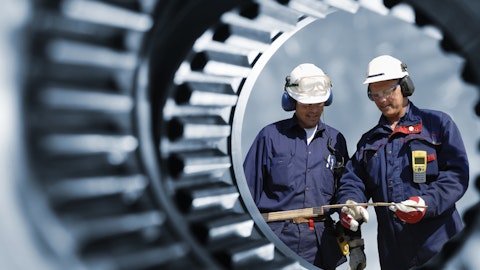We expect approximately $60 million of cash usage from working capital and turnaround-related cash costs combined. This is approximately $15 million higher than our prior guidance and is driven by unfavorable payment terms with European utilities. And cash taxes are expected to be about $15 million or $2.5 million lower than our prior guidance. This concludes my prepared remarks. I will now turn the call back to Thomas.
Thomas Fahnemann: Thank you, Ramesh. As I referenced during our previous second quarter call, there are several areas that are extremely important for us to deliver on for the remainder of 2023 and well into 2024. Our customers’ expectations of us remain very high for navigating the challenging economic headwinds. The management team and I continue to carefully evaluate the ongoing cost to serve our customers and make the appropriate adjustments while delivering on our high product standards and overall sustainability goals. Recently, our performance was recognized when Glatfelter’s Asheville facility was awarded the prestigious supplier of the year designation by Rockline Industries to further distinguish us as a business partner who shares Rockline’s core values.
In addition, we have been nominated as a finalist for the 2023 Hygienix Innovation Award for our GlatPure product range, which includes a full complement of bio-based absorbent hygiene components derived from renewable materials. And last but certainly not least, we will further advance all efforts related to the turnaround strategy as this program has served us very well throughout 2023. While not a new theme, we will continue our efforts to optimize our product portfolio, along with balancing price versus volume. Also, we will capture ongoing operational efficiencies by investing in our most productive assets, and we will refine our organizational structure to optimize resources while conveying a sense of urgency and accountability. We are committed to instilling a culture of continuous transformation as an ongoing way of doing business, which I’m confident will serve us well for many years to come.
When combined, the power of all these actions is aimed at positioning the company to capture the markets as they begin to improve at some point in the future. I will now open the call for questions.
Operator: Thank you, Thomas. [Operator instructions] Our first call comes from Josh Wool with Carlson Capital. Please go ahead, sir. Your line is open.
Josh Wool: Thomas, Ramesh, good morning. Thanks for taking my questions.
Ramesh Shettigar : Good morning, Josh.
Thomas Fahnemann: Morning.
Josh Wool: As usual, I’ll start with the top line and then move down to EBITDA and margin, and then I have a few questions on cash flow and the guide. Starting with volumes, obviously, destocking has taken a toll on your customers and some of your competitors, but some of these players were able to report sequential volume improvement. However, your volumes, particularly in composite fibers and spunlace, weakened sequentially. So maybe you could give a little bit more color on what drove the decline. And particularly in composite fibers, how much of that was driven by the shut of Ober-Schmitten? And then how much was walking away from unprofitable business or destocking getting worse or losing share to some of these other substrates?
Thomas Fahnemann: Okay. Yeah, let me just maybe go through the different segments because every segment is behaving a little bit different, Josh. So let’s maybe talk about destocking, which we were hoping that we are done with that, but it’s still ongoing. And what we are experiencing in the – what we experienced in the third quarter. So if I go through the different segments, definitely feminine hygiene segment is still on a path of destocking. So we see some weakness in the market overall, plus destocking. So that’s one area where we definitely see this, which we didn’t expect. The other one is a tabletop foodservices. Normally, Q3 is a relatively strong quarter. I mean, you have all these outside activities for the restaurant business and all this, and this has been relatively weak.
And there’s also still destocking happening, and it happened in the third quarter. Moving on, we are also seeing it in certain subsegments of our wipes business, where we still have some demand, is actually relatively stable, what we can see. But there are still a lot of inventories at our customers, and they are destocking here. And then let me talk about the food and beverage businesses a little bit. I think we have kind of two areas and two things going on there. If I may start with coffee, there’s still destocking going on. And what we’re also seeing is that although overall coffee consumption is stable, even maybe growing a little bit, we are seeing, and this is mainly true for Europe, a move from single serve, where we are participating to normal filter coffee, and that’s a price issue.
So there, we see some weakness. And overall tea, although, overall, an underlying demand is still, I would say, relatively stable. Customers are still sitting on a lot of inventory coming from 2021 and 2022. So that’s kind of the – and if I look at – maybe if I look more in the area of spunlace, I would say in that area the critical cleaning segment is probably the one which is most impacted, still impacted by destocking.
Josh Wool: Okay. That’s helpful. And then maybe to compare a little bit the regions or I guess Europe versus North America, one of your competitors in wipes talked about seeing more consumer weakness and more competitive intensity in Europe versus North America. And it seems like you called out some of the same things this morning in your press release in airlaid. So how would you compare Europe versus North America? And is it a secular trend or just a kind of a moment in time?
Thomas Fahnemann: No, I think there’s a couple of issues here, Josh. Number one, what we are seeing is that the overall economy is weaker in Europe compared to the U.S., and we also see that consumers are relatively hesitant. And so we see definitely the U.S markets are still much healthier than the European market. On top of this very, I would say, weak macroeconomic environment in Europe, what we’re also seeing that we have relatively inexpensive imports coming in from Turkey, from Asia, China, which are also negatively impacting it. And we are seeing also in Europe some in some areas some trends of trying to substitute certain products with — with cheaper substrates. So all that is coming up, but I would totally agree Europe is much more challenging than the U.S.



